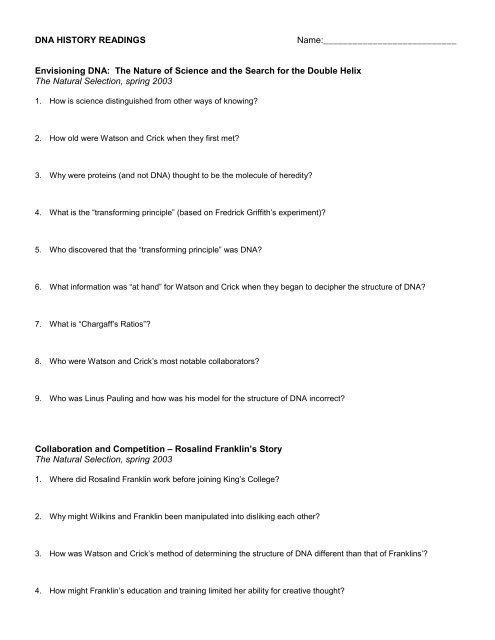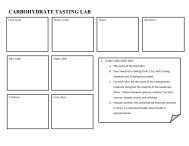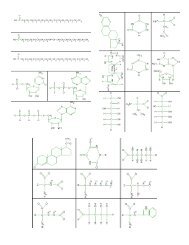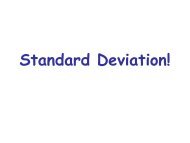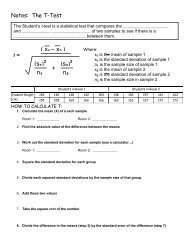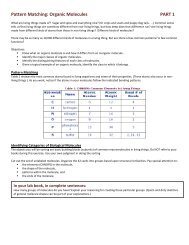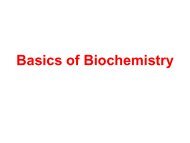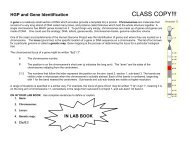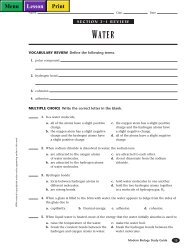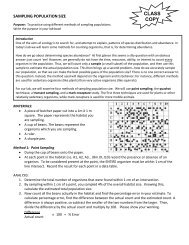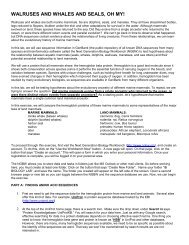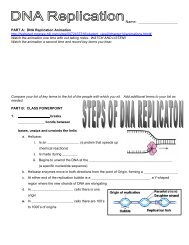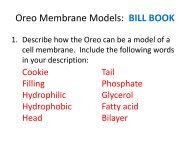DNA HISTORY READINGS - Biology for Life
DNA HISTORY READINGS - Biology for Life
DNA HISTORY READINGS - Biology for Life
Create successful ePaper yourself
Turn your PDF publications into a flip-book with our unique Google optimized e-Paper software.
<strong>DNA</strong> <strong>HISTORY</strong> <strong>READINGS</strong>Name:___________________________Envisioning <strong>DNA</strong>: The Nature of Science and the Search <strong>for</strong> the Double HelixThe Natural Selection, spring 20031. How is science distinguished from other ways of knowing?2. How old were Watson and Crick when they first met?3. Why were proteins (and not <strong>DNA</strong>) thought to be the molecule of heredity?4. What is the “trans<strong>for</strong>ming principle” (based on Fredrick Griffith’s experiment)?5. Who discovered that the “trans<strong>for</strong>ming principle” was <strong>DNA</strong>?6. What in<strong>for</strong>mation was “at hand” <strong>for</strong> Watson and Crick when they began to decipher the structure of <strong>DNA</strong>?7. What is “Chargaff’s Ratios”?8. Who were Watson and Crick’s most notable collaborators?9. Who was Linus Pauling and how was his model <strong>for</strong> the structure of <strong>DNA</strong> incorrect?Collaboration and Competition – Rosalind Franklin’s StoryThe Natural Selection, spring 20031. Where did Rosalind Franklin work be<strong>for</strong>e joining King’s College?2. Why might Wilkins and Franklin been manipulated into disliking each other?3. How was Watson and Crick’s method of determining the structure of <strong>DNA</strong> different than that of Franklins’?4. How might Franklin’s education and training limited her ability <strong>for</strong> creative thought?
A Structure <strong>for</strong> Deoxyribose Nucleic AcidNature, Vol. 171, April 19531. Who wrote the article?2. What two reasons did the authors give <strong>for</strong> rejecting the previously published hypothesis of Linus Pauling?3. What general structure do the authors propose <strong>for</strong> <strong>DNA</strong>?4. Do the two chains run in the same direction?5. How many times does the molecular structure repeat <strong>for</strong> one complete turn? (Hint: Each nucleotide is referred toas a "residue")6. How long is one complete turn of the helix?7. What holds the two chains together?8. How do the purine and pyrimidine bases always pair together? What previously discovered evidence supports thisfact? Who discovered this evidence?9. Why can't the model be constructed of ribose sugar instead of deoxyribose?10. Who is credited <strong>for</strong> experimental evidence to support the hypothesis proposed?


